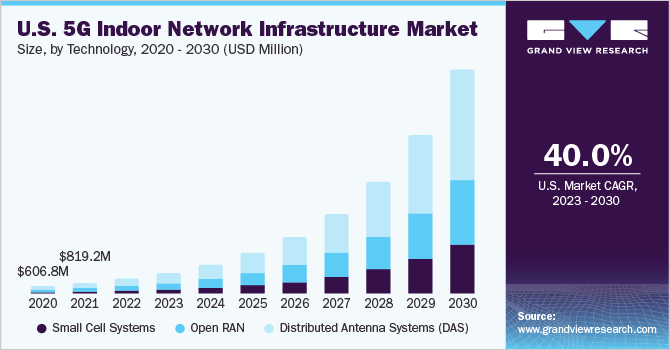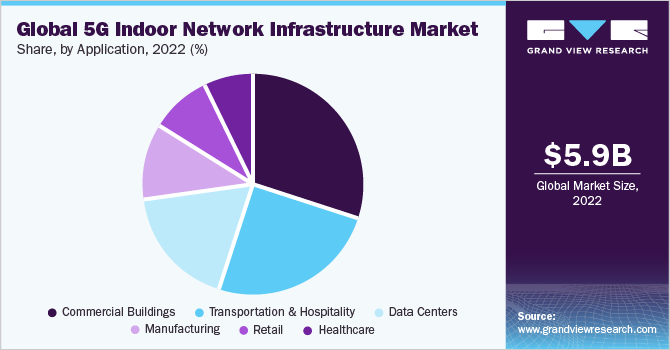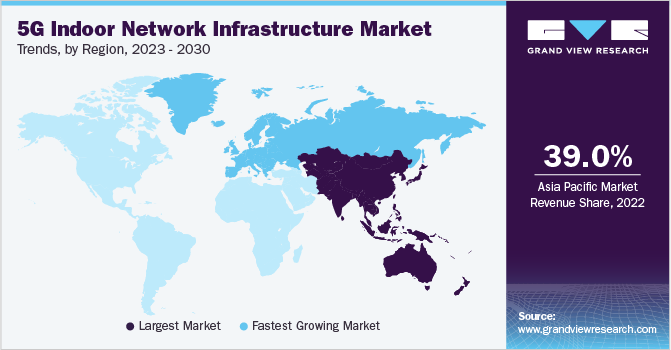- Home
- »
- Next Generation Technologies
- »
-
5G Indoor Network Infrastructure Market Size Report, 2030GVR Report cover
![5G Indoor Network Infrastructure Market Size, Share & Trends Report]()
5G Indoor Network Infrastructure Market (2023 - 2030) Size, Share & Trends Analysis Report By Technology (DAS, Open RAN), By Spectrum (Sub-6 GHz, mmWave), By Application, By Network Architecture, By Region, And Segment Forecasts
- Report ID: GVR-4-68040-063-7
- Number of Report Pages: 115
- Format: PDF
- Historical Range: 2020 - 2021
- Forecast Period: 2023 - 2030
- Industry: Technology
- Report Summary
- Table of Contents
- Segmentation
- Methodology
- Download FREE Sample
-
Download Sample Report
5G Indoor Network Infrastructure Market Summary
The global 5G indoor network infrastructure market size was estimated at USD 5.96 billion in 2022 and is projected to reach USD 87.79 billion by 2030, growing at a CAGR of 40.2% from 2023 to 2030. With the growing traction and deployment of 5G, the fifth generation of networks, the demand for 5G-network infrastructure has surged, thereby creating a significant opportunity for market growth.
Key Market Trends & Insights
- Asia Pacific dominated the global market in 2022 and accounted for a revenue share of more than 39.0%.
- Europe is expected to emerge as the fastest-growing regional market over the forecast period.
- By technology, the distributed antenna systems (DAS) segment dominated the market in 2022.
- By network architecture, the non-standalone segment dominated the market in 2022 and accounted for a revenue share of more than 84.0%.
- By Spectrum, the sub-6 GHz segment dominated the market in 2022 and accounted for a revenue share of more than 74.0%.
Market Size & Forecast
- 2022 Market Size: USD 5.96 Billion
- 2030 Projected Market Size: USD 87.79 Billion
- CAGR (2023-2030): 40.2%
- Asia Pacific: Largest market in 2022
- Europe: Fastest growing market
5G indoor network infrastructure enables new possibilities for operational efficiency with industrial automation, IoT, and new communication services. The growing adoption of 5G services due to their speed and the increasing importance of indoor network infrastructure for industrial and commercial usage is expected to drive market growth.
The introduction of mobile LTE revolutionized communication systems. However, consumers and industries are moving faster towards a much more sophisticated 5G network. 5G enables the bandwidth of up to 10 and 20 Gbps depending on the availability of spectrum. In buildings, the 5G indoor network infrastructure will enable augmented reality (AR), virtual reality (VR), and mixed reality applications delivered to wireless devices with manufacturing and entertainment applications. The growing demand for these advanced technologies to improve and automate the manufacturing process in the manufacturing industry and the ever-increasing demand for larger-than-life entertainment experiences in the media & entertainment industry are propelling the demand for 5G indoor network infrastructure.
The growing adoption of work-from-home models and increasing digital transformation of industries are expected to propel the 5G data traffic originating from indoors. The changing working models and rapid digital transformations have made black calls, dropped calls, and poor bandwidth unacceptable for businesses and consumers, as most of their work depends on connectivity in this changing digital world. Due to this, indoor 5G coverage has become essential, and governments and telecom operators across the globe are focusing on providing better 5G coverage by deploying better 5G indoor and outdoor infrastructure. For instance, in February 2020, the Ministry of Industry and Information Technology (MIIT) granted licenses to China Mobile, China Unicom, and China Telecom to jointly use the 3.3-gigahertz to 3.4GHz spectrum for 5G indoor coverage nationwide.
Such initiatives are driving the market’s growth. The early 5G deployments had been implemented to provide enhanced mobile broadband to the consumer market as the core proposition. However, 5G prospects in massive IoT and ultra-reliable low-latency communications have gained scale at a later stage. 5G provides potentially lower costs and faster means, expanding the high-speed offerings to businesses and households. The benefits provided by 5G bring a greater opportunity for market players to gain a larger share and incremental revenue. Private players are investing in the 5G indoor network infrastructure, as it is still a niche market with plenty of untapped consumer base and a promising future. The rapid investments and innovations in the market are expected to create significant growth opportunities over the forecast period.
According to GSM Association (GSMA), by 2025, one-third of the world’s population will be connected to 5G. Deploying 5G will benefit and change our societies. However, to deliver the real benefits of 5G, many challenges need to be addressed, starting from infrastructure and network security to expanding it across all spheres. Frequency band and spectrum availability, use of multiple small antennas and base stations, intricate architecture, and the need for skilled professionals are challenging the 5G industry. However, 5G indoor network infrastructure will play a crucial role in tackling these challenges, creating growth opportunities in the market.
COVID-19 Impact Analysis
The COVID-19 pandemic drastically affected businesses across the world. However, as the world recovers from the impacts of the pandemic, the COVID-19 pandemic challenge does not present an insurmountable challenge. The impact of the pandemic varied across industries and countries. In 2020, it was anticipated that the 5G (at least in its early stage) would see a global rollout. But these rollouts were slowed down due to the pandemic on account of significant supply chain interruptions and lockdowns across the globe. However, it led to fundamental changes, such as work-from-home models, enabling people to be more efficient in a socially distant world, which is expected to drive significant investments in the 5G industry. As the world recovers from the adversities of the pandemic, 5G indoor network infrastructure is expected to play a crucial role in improving global connectivity.
Technology Insights
The distributed antenna systems (DAS) segment dominated the market in 2022 and accounted for a revenue share of more than 48.0%. The growing demand for DAS can be attributed to their ability to help distribute 5G signals indoors. Traditional 5G cell towers provide 5G coverage outdoors, while 80% of data usage occurs indoors by consumers and businesses. Building materials, such as concrete, metal, and glass can block the signals from the cell towers, which hampers the 5G connectivity indoors. Moreover, many indoor venues already consist of DAS that can be upgraded for 5G coverage, making it quicker in deployment and less costly, which contributed to the segment gaining a large market share in 2022. The small cell systems segment is anticipated to register the fastest growth rate over the forecast period.
Small cell systems are standalone technology in the market. They are small and modular and enhance 5G connectivity indoors. Small cells benefit operators and IT managers who may be responsible for multiple locations, businesses, and campuses where buildings vary in size and user traffic. Moreover, they are cost-effective and modular high-performance solutions that can cover a wide range of indoor environments with a common solution for better coverage. When the number of 5G users will increase rapidly, the existing infrastructure will become insufficient, and businesses & consumers will shift to new network infrastructure, such as small cell systems, which is expected to drive the segment’s growth over the forecast period.
Network Architecture Insights
The non-standalone segment dominated the market in 2022 and accounted for a revenue share of more than 84.0%. The initial rollout of 5G included providing customers with 5G coverage using the existing (non-standalone, compatible with 4G & LTE, and upgraded for 5G) infrastructure. Network providers offered their customers 5G services with higher data transfer speeds by pairing a 5G RAN with LTE evolved packet core. The non-standalone network infrastructure of 5G indoor network infrastructure was easy to deploy and cost-effective at the initial stage of 5G rollouts, contributing to the dominating share of the non-standalone segment.
The standalone segment is anticipated to register the fastest growth rate over the forecast period. Even though the initial rollouts of 5G constituted non-standalone networks, as the network evolves and more & more businesses & consumers move to 5G connectivity, the non-standalone networks will be insufficient. At that juncture, standalone 5G will bring faster, more reliable, and largely capable telecommunications. The standalone indoor network infrastructure presents logistical, financial, and operational roadblocks. However, 5G service providers are investing heavily to tackle these issues and move forward with the standalone networks, which are expected to fuel the market’s growth over the forecast period.
Spectrum Insights
The sub-6 GHz segment dominated the market in 2022 and accounted for a revenue share of more than 74.0%. The sub-6 GHz spectrum uses frequencies below 6GHz, where the 4G, 3G, and 2G networks have historically operated. This has made the deployment of 5G easier using the existing systems. 5G carriers have successfully deployed nationwide networks quickly by using their existing towers and spectrums, as sub-6 5G does not require more than tower upgrades. With the sub-6 GHz spectrum, telecom operators can provide relatively high output with 5G without compromising their 4G offerings, which has contributed to the significant share of the segment in 2022.
The mmWave (millimeter wave) segment is anticipated to register the fastest growth rate over the forecast period. mmWave spectrum uses significantly higher frequencies ranging between 30 and 300 GHz. Carriers currently operate between 30 and 40 GHz. Hence, mmWave 5G coverage can use previously untouched spectrum and provide tremendous data speeds and ultralow latency. Moreover, the mmWave can allow future communications between devices, cars, and medical equipment. The vital and vast benefits of the mmWave spectrum are expected to drive the segment’s growth over the forecast period.
Application Insights
The commercial buildings segment dominated the market in 2022 and accounted for a revenue share of over 30.0%. The 5G indoor network infrastructure provides various benefits in commercial buildings, which contributed to the segment's dominant market share in 2022. Some of these benefits include enhanced IoT capabilities, increasing data collection capabilities, and adding enhanced value to buildings. The 5G indoor network infrastructure is used in commercial buildings to enhance 5G connectivity, support user experience, and connect teams at multiple locations all at once, driving the segment's growth. The manufacturing segment is anticipated to register significant growth over the forecast period.

5G technologies provide fundamental network characteristics, such as low latency and high reliability, which are needed to support critical applications. Moreover, it allows manufacturers to build smart factories and take advantage of advanced technologies, such as Artificial Intelligence (AI), automation, AR for troubleshooting, and the Internet of Things (IoT). One of the roadblocks faced by the manufacturing industry is connectivity issues in warehouses and factories, which are generally located on the outskirts of the cities. 5G indoor network infrastructure helps manufacturers tackle this problem, which is expected to drive its adoption in manufacturing applications over the forecast period.
Regional Insights
Asia Pacific dominated the global market in 2022 and accounted for a revenue share of more than 39.0%. The 5G network rollout across the Asia Pacific region has been uneven, with developed markets, such as China, Singapore, South Korea, and Australia, leading the way. The growth of the regional market can be attributed to enterprise use cases, such as robotics, that take advantage of the low-latency capabilities of technology. The growing government initiatives in countries, such as China and India, are expected to fuel the regional market’s growth. Moreover, the APAC region houses several countries with high populations, which leads to dense infrastructure. 5G indoor network infrastructure is highly suitable for providing 5G connectivity in densely populated areas, thus driving the regional market.

Europe is expected to emerge as the fastest-growing regional market over the forecast period. The European governments are looking at 5G infrastructure as the key to accelerating the use of 5G in automation, the Internet of Things (IoT), smart manufacturing, and smart buildings. The Europe region houses many countries with large manufacturing plants. Manufacturers in this region are looking for 5G connectivity to automate their processes to earn larger profits, greater precision, and enhanced accuracy. The growing use of 5G technologies in indoor applications, such as manufacturing, commercial buildings, transportation & hospitality, data centers, health care, and retail, is driving the market growth in the European region.
Key Companies & Market Share Insights
The industry can be described as a consolidated market. Key companies are adopting expansion and partnership strategies to cater to the increased demand, especially from telecom operators to provide enhanced 5G connectivity indoors. The key market players are launching innovative solutions to boost 5G coverage indoors. For instance, in February 2023, Telefonaktiebolaget LM Ericsson announced the expansion of its indoor mobile connectivity portfolio by introducing three cost-effective and easily-deployable solutions. These solutions are a part of the Ericsson Radio Dot System Portfolio and aim to provide 5G coverage, greater capacity, and improved capabilities within indoor work or business environments, regardless of the size or complexity of the structure. Such initiatives are harnessing the growth of the market. Prominent players in the global 5G indoor network infrastructure market include:
-
Airspan Networks
-
Samsung Electronics Co., Ltd.
-
CommScope Holding Company, Inc.
-
Telefonaktiebolaget LM Ericsson
-
Nokia
-
Huawei Technologies Co., Ltd.
-
Corning Incorporated
-
Comba Telecom Systems Holdings Ltd.
5G Indoor Network Infrastructure Market Report Scope
Report Attribute
Details
Market size value in 2023
USD 8.24 billion
Revenue forecast in 2030
USD 87.79 billion
Growth rate
CAGR of 40.2% from 2023 to 2030
Base year of estimation
2022
Historical data
2020 - 2021
Forecast period
2023 - 2030
Quantitative units
Revenue in USD million/billion and CAGR from 2023 to 2030
Report coverage
Revenue forecast, company market share, competitive landscape, growth factors, and trends
Segments covered
Technology, network architecture, spectrum, application, region
Regional scope
North America; Europe; Asia Pacific; Latin America; MEA
Country scope
U.S.; Canada; UK; Germany; France; Italy; Spain; China; India; Japan; South Korea; Brazil; Mexico ; UAE; Kingdom of Saudi Arabia; South Africa
Key companies profiled
Airspan Networks; Samsung Electronics Co., Ltd.; CommScope Holding Company, Inc.; Telefonaktiebolaget LM Ericsson; Nokia; Huawei Technologies Co., Ltd.; Corning Inc.; Comba Telecom Systems Holdings Ltd.
Customization scope
Free report customization (equivalent to up to 8 analysts’ working days) with purchase. Addition or alteration to country, regional & segment scope
Pricing and purchase options
Avail customized purchase options to meet your exact research needs. Explore purchase options
Global 5G Indoor Network Infrastructure Market Report Segmentationn
This report forecasts revenue growth and provides an analysis of the latest trends in each of the sub-segments from 2020 to 2030. For this report, Grand View Research has segmented the global 5G indoor network infrastructure market based on technology, network architecture, spectrum, application, and region:
-
Technology Outlook (Revenue, USD Million, 2020 - 2030)
-
Distributed Antenna Systems (DAS)
-
Small Cell Systems
-
Open RAN
-
-
Network Architecture Outlook (Revenue, USD Million, 2020 - 2030)
-
Standalone
-
Non-standalone
-
-
Spectrum Outlook (Revenue, USD Million, 2020 - 2030)
-
Sub-6 GHz
-
mmWave
-
-
Application Outlook (Revenue, USD Million, 2020 - 2030)
-
Retail
-
Transportation & Hospitality
-
Manufacturing
-
Commercial Buildings
-
Data Centers
-
Healthcare
-
-
Regional Outlook (Revenue, USD Million, 2020 - 2030)
-
North America
-
U.S.
-
Canada
-
-
Europe
-
UK
-
Germany
-
France
-
Italy
-
Spain
-
-
Asia Pacific
-
China
-
India
-
Japan
-
South Korea
-
-
Latin America
-
Brazil
-
Mexico
-
-
Middle East & Africa
-
UAE
-
Kingdom of Saudi Arabia
-
South Africa
-
-
Frequently Asked Questions About This Report
b. The global 5G indoor network infrastructure market size was estimated at USD 5.96 billion in 2022 and is expected to reach USD 8.24 billion in 2023.
b. The global 5G indoor network infrastructure market is expected to grow at a compound annual growth rate of 40.2% from 2023 to 2030 to reach USD 87.79 billion by 2030.
b. Asia Pacific region dominated the 5G indoor network infrastructure market. The growth of the regional market can be attributed to enterprise use cases, such as robotics, that take advantage of the low-latency capabilities of technology. The growing government initiatives in countries such as China and India are expected to fuel the regional market’s growth.
b. Some key players operating in the 5G indoor network infrastructure market include Airspan Networks, SAMSUNG ELECTRONICS CO., LTD., CommScope Holding Company, Inc., Telefonaktiebolaget LM Ericsson, Nokia, Huawei Technologies Co., Ltd., Corning Incorporated, Comba Telecom Systems Holdings Ltd.
b. The growing adoption of 5G services due to their speed and the increasing importance of indoor network infrastructure for industrial and commercial usage is expected to drive the market’s growth.
Share this report with your colleague or friend.
Need a Tailored Report?
Customize this report to your needs — add regions, segments, or data points, with 20% free customization.

ISO 9001:2015 & 27001:2022 Certified
We are GDPR and CCPA compliant! Your transaction & personal information is safe and secure. For more details, please read our privacy policy.
Trusted market insights - try a free sample
See how our reports are structured and why industry leaders rely on Grand View Research. Get a free sample or ask us to tailor this report to your needs.










